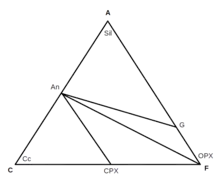
In metamorphic geology, a compatibility diagram shows how the mineral assemblage of a metamorphic rock in thermodynamic equilibrium varies with composition at a fixed temperature and pressure. Compatibility diagrams provide an excellent way to analyze how variations in the rock's composition affect the mineral paragenesis that develops in a rock at particular pressure and temperature conditions.[1] Because of the difficulty of depicting more than three components (as a ternary diagram), usually only the three most important components are plotted, though occasionally a compatibility diagram for four components is plotted as a projected tetrahedron.[2]
Construction
A three-component compatibility diagram will depict the stable phase of each pure component as the point at each corner of a ternary diagram. Additional points in the diagram represent other pure phases, and lines connecting pairs of these points represent compositions at which the two phases are the only phases present. These lines generally divide the diagram into subtriangles since, in accordance with Gibb's phase rule, a system of three components will contain three phases except at the degenerate compositions represented by the points and lines. The composition within each subtriangle will be a mixture of the pure phases found at the corners of the subtriangle. These are the compatible phases for the composition at the temperature and pressure (and, sometimes, degree of water saturation) for which the diagram is prepared.[3][4]
Common types


Certain choices of components have proven particularly useful in metamorphic petrology.
ACF diagram
An ACF diagram is particularly suitable for describing basaltic metamorphic rocks. Its components are:[5]
- A = Al2O3 + Fe2O3 - (Na2O + K2O)
- C = CaO
- F = FeO + MgO + MnO
That is, the components are various combinations of the mol% of important metal oxides in the rock. If the rock is assumed to be saturated with quartz and carbon dioxide (though not depicted in the diagram), then at elevated temperature (granulite facies), the corner phases are calcite, sillimanite, and orthopyroxene. The side of the diagram between calcite and sillimanite has a point added for anorthite (calcium feldspar), corresponding to an equal mixture (by mole percentage) of the two components. This forms pure anorthite. Likewise, points are added for clinopyroxene and garnet and the diagram is divided into subtriangles, as depicted in the accompanying diagram.[6]
AKF diagram
The AKF diagram is intended for rocks containing excess aluminium and silica. Its components are:
- A = Al2O3 - (CaO + Na2O + K2O)
- K = K2O
- F = FeO + MgO + MnO
This diagram is less useful, because magnesium does not freely substitute for ferrous iron in many metamorphic minerals important in aluminium-rich rock. These are better regarded as separate components, producing a tetrahedral compatibility diagram.[7]
See also
- Petrogenetic grid – Pressure-temperature diagram of mineral stability ranges
References
- ↑ Yardley, B. W. D. (1989). An introduction to metamorphic petrology. Harlow, Essex, England: Longman Scientific & Technical. pp. 32–33. ISBN 0582300967.
- ↑ Philpotts, Anthony R.; Ague, Jay J. (2009). Principles of igneous and metamorphic petrology (2nd ed.). Cambridge, UK: Cambridge University Press. p. 447. ISBN 9780521880060.
- ↑ Philpotts & Ague 2009, pp. 454–457.
- ↑ Yardley 1989, pp. 32–33.
- ↑ Philpotts & Ague 2009, pp. 454–456.
- ↑ Philpotts & Ague 2009, p. 455.
- ↑ Philpotts & Ague 2009, p. 457.